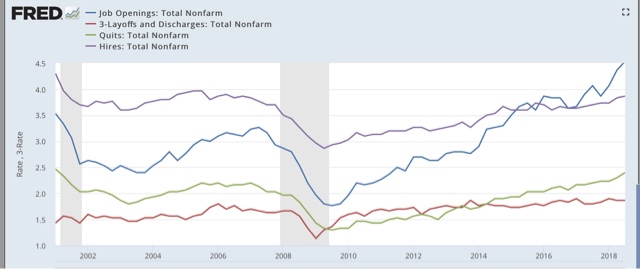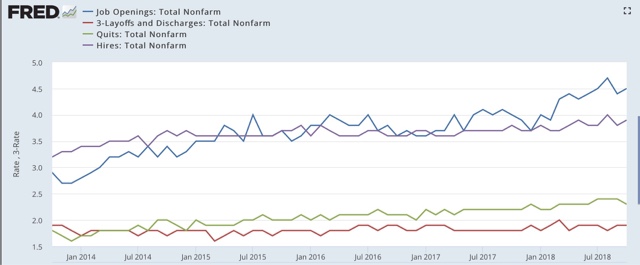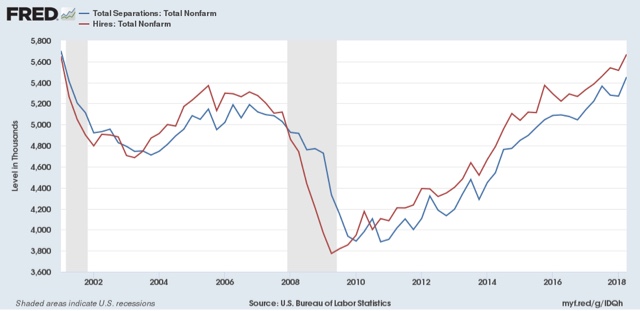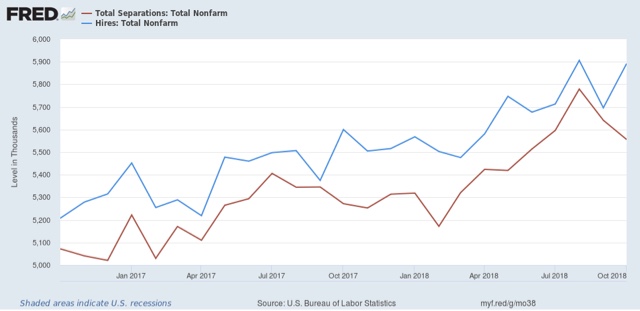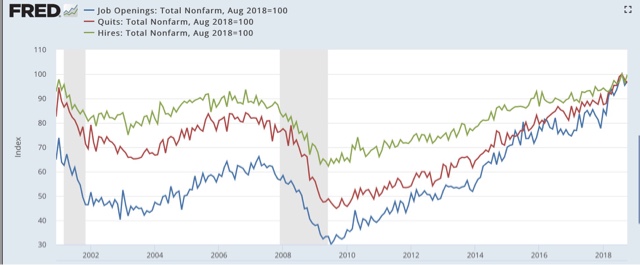The October JOLTS report: very good employment market continues, just below best levels Monday’s JOLTS report for October was, surprisingly, a little weaker than the employment report from one month ago, that I described at the time as perhaps the best in the entire expansion. But this is a relative statement; basically, most of the series were only a little off their recent best readings: Quits were just below their all-time high in August, and July as well. Hires were just below their August best. Total separations made another new expansion high Layoffs and discharges declined a little from August and September levels (a positive), although they are slightly elevated compared to last spring. Job openings were also just below their all time high in
Topics:
NewDealdemocrat considers the following as important: US/Global Economics
This could be interesting, too:
Joel Eissenberg writes How Tesla makes money
Angry Bear writes True pricing: effects on competition
Angry Bear writes The paradox of economic competition
Angry Bear writes USMAC Exempts Certain Items Coming out of Mexico and Canada
The October JOLTS report: very good employment market continues, just below best levels
Monday’s JOLTS report for October was, surprisingly, a little weaker than the employment report from one month ago, that I described at the time as perhaps the best in the entire expansion. But this is a relative statement; basically, most of the series were only a little off their recent best readings:
- Quits were just below their all-time high in August, and July as well.
- Hires were just below their August best.
- Total separations made another new expansion high
- Layoffs and discharges declined a little from August and September levels (a positive), although they are slightly elevated compared to last spring.
- Job openings were also just below their all time high in August, as well as September.
Let’s update where the report might tell us we are in the cycle, remaining mindful of the fact that we only have 18 years of data. Below is a graph, averaged quarterly through the third quarter, of the *rates* of hiring, quits, layoffs, and openings as a percentage of the labor force since the inception of the series (layoffs and discharges are inverted at the 3% level, so that higher readings show fewer layoffs than normal, and lower readings show more):
- Hires peaked first, from December 2004 through September 2005
- Quits peaked next, in September 2005
- Layoffs and Discharges peaked next, from October 2005 through September 2006
- Openings peaked last, in Spril 2007
By contrast during and after the last recession:
- Layoffs and Discharges troughed first, from January through April 2009
- Hiring troughed next, in March and June 2009
- Openings troughed next, in August 2009
- Quits troughed last, in August 2009 and again in February 2010
Now here’s what the four metrics look like on a monthly basis for the last five years:
Through August, job openings, quits, and hires have all surged higher this year, with openings virtually “on fire.” In the last two months of data there’s been a pause, but nothing that suggests a downtrend.
Next, here’s an update to the simple metric of “hiring leads firing,” (actually, “total separations”). Here’s the long term relationship since 2000 through Q3 of this year:
Here is the monthly update for the past two years measured YoY:
In the 2000s business cycle, hiring and then firing both turned down well in advance of the recession. Both are still advancing. The recent relative surge in separations might just be noise.
Finally, let’s compare job openings with actual hires and quits. As you probably recall, I am not a fan of job openings as “hard data.” They can reflect trolling for resumes, and presumably reflect a desire to hire at the wage the employer prefers. In the below graph, the *rate* of each activity is normed to 100 at its August 2018 value, since that has been the recent peak:
When I first presented this graph, I noted that while the rate of job openings is at an all time high, the rate of actual hires has only just reached its normal rate during the several best years of the 2000s expansion, and is below its rate at the end of the 1990s expansion.
This year both hires and quits have accelerated, with hiring decisively above its level from the last expansion — although, as you can see in the first graph above, the *rate* of hiring remains below that of the 2000s expansion. My take has been that employees have reacted to the employer taboo against raising wages by quitting at high rates to seek better jobs elsewhere. If the dam is finally breaking, we should see the hiring rate increase, and quit rate level off.

